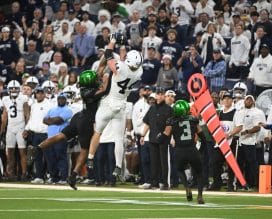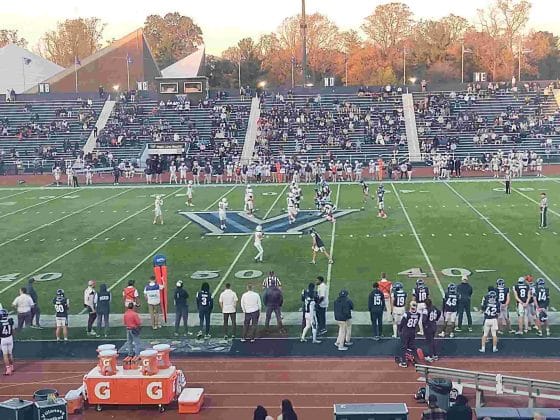Flyers
Flyers-Penguins Observations: Dreadful Defense
By Kevin Durso, Sports Talk Philly editor
When the Flyers lost four straight games (0-3-1) after solid wins in the first two games of the season, there was this “here we go again” vibe. When the Flyers finally got some regular time at home, something they had not had since the first week of the preseason, it marked the team’s first test, rebounding from a week that brought forth a lot of questions.
They passed with flying colors — a convincing 6-2 win over Vegas, a solid 4-1 win over Chicago, and just when you thought the Flyers were going to lose a game where the bounces didn’t go their way and the goaltending wasn’t bailing them out, they scored five goals in the third period to rally past Columbus, marking a three-game winning streak.
To this point, the Flyers had played nine games, going 5-3-1, and the record wasn’t really indicative of the performance. The Flyers had out-shot their opponent in eight of nine games, losing that battle only in a lifeless loss in Calgary. Even in losses to Edmonton and Dallas that looked lopsided on the scoreboard, the Flyers had their moments where they either carried the play or heavily out-shot the opponent, leaving limited chances for the opposition.
As Sunday’s action started, the Flyers had played just two games against Eastern Conference teams — their 4-0 win over New Jersey in the home opener and Saturday’s dramatic comeback win over Columbus. The real first test was just beginning for the Flyers.
The Metro is going to be very competitive and however you classified the Flyers entering the season in terms of playoff potential, they were always going to be competing with five or six others in an eight-team division for four or five playoff spots that are available. Games within the division are going to be crucial. Even in games that the Flyers can’t find a way to win, what you at least wanted to see was the same competitive nature of the game. When the Flyers didn’t have their best in Calgary or against Dallas or even when things snowballed out of control in Edmonton, there were periods where the game was still one opportunity or bounce away from being very different.
In Calgary, the margin was one goal for the majority of the game, including most of the third period after the Flyers scored to make it 2-1. The urgency didn’t seem to be there, but the margin was able to be erased.
In Edmonton, the Flyers were dominating the second period, down by just a goal, before Connor McDavid used his speed to score and that jump started a three-goal rally that put the game out of reach.
Against Dallas, the Flyers trailed 2-1 through the entire second period and 3-1 for most of the third while allowing Dallas just two shots for nearly 40 minutes. Again, it was competitive.
That’s where Sunday’s game and now Tuesday’s drubbing in Pittsburgh was so alarming.
The Flyers are still tied for first in the NHL for fewest shots allowed per game in the NHL. They were tied for 13th in goals allowed per game prior to Tuesday. Their power play and penalty kill were both ranking in the Top 10 in the league. Even the advanced analytics favored the Flyers. Through 10 games, they had a league-best 54.97 CF% at 5-on-5.
You wouldn’t have known it from Tuesday’s performance. The Flyers looked their best when they were shorthanded, and they did successfully kill off all three Pittsburgh power plays to bring their penalty kill up to sixth in the NHL. But at 5-on-5, if it could go wrong, it did go wrong.
If the underlying numbers are not the problem, then what is? Simply put, the defensive play has been an atrocity in the last two games.
Let’s not sugarcoat Sunday’s 5-3 final against the Islanders. The game was not really that close. And there’s no sugarcoating a 7-1 loss to your biggest rival.
Sunday’s game certainly had the potential to be an anomaly. It was the worst defensive game the Flyers had played so far. The Flyers were playing their third game in four nights and had expended a lot of energy in the third period of the previous game. To be fair, their assessments after that game were honest. Jake Voracek said he believed it was the first time this season they had been out-skated by an opponent. They were badly outworked on the forecheck. It should have served as a wake up call that these games are, obviously, not going to be easy.
The Islanders certainly exposed the Flyers with relentless pressure on the puck, leading to mistakes, missed coverages and turnovers. When you play like that in your own zone, you are not going to survive for long and it’s why the Flyers have allowed 12 goals in the last two games.
When the team has allowed 12 goals in two games and 16 in three games, the first place you look is the goalie. There wasn’t really a single goal in Tuesday’s loss you could pin on the netminder.
You actually have to give Brian Elliott some credit for taking it on the chin. He was left out to dry with no real chance on at least four of the goals he allowed. It would have been understandable if he was pulled at 3-0, 4-0 or after the first period.
It was the team in front of him that was the problem. Just look at each of the Penguins four goals in the first period, where the game was lost almost before it had a chance to start.
Three different Flyers are involved on the first goal. Shayne Gostisbehere makes a weak play on the boards, dropping the puck behind the net, without much pressure. Robert Hagg has to go retrieve and gets bodied off the puck by Bryan Rust. Michael Raffl gets to the puck and has one play, to try to clear along the boards. His clearing attempt is weak and goes right to Justin Schultz. Shot, goal.
The second goal is a classic case of lazy defense. The puck gets between Ivan Provorov and Tyler Pitlick. Pitlick is at the right circle, and waits for Provorov to make a play when he should be moving and trying to help gain possession. This allows the Penguins to swarm. Two Pittsburgh players end up in a battle at the side of the net. Mikhail Vorobyev ends up below the goal line, virtually a spectator. Chris Stewart gets caught puck watching as well. Despite good positioning from Matt Niskanen, he’s not able to break up the play and Jared McCann comes in unmarked. Slam dunk.
Travis Sanheim falls on the fourth Penguins goal, allowing an easy entry. The eventual goal scorer, Sidney Crosby, is marked by Pitlick on entry, but randomly Pitlick leaves his post and drifts to the middle of the ice. If there is any player in the league you leave unmarked, it sure as hell is not Sidney Crosby. A quick pass across, a laser of a shot and a goal.
This is what is alarming about all of these plays. These are fundamentals. These are preventable mistakes. This is not system-related and not a coaching issue. This is just bad hockey.
The Flyers have Wednesday off for some much-needed rest after so many games and that should be welcomed. There is another back-to-back on Friday and Saturday against two more Eastern Conference teams. The Flyers are already falling into that trap of being consistently inconsistent, at least by the results. Win two, lose four, win three, lose two — it’s maddening.
While the Flyers have certainly taken a different approach to playing and it has looked good for eight games of 11 so far this season, that can change all too quickly as teams, especially those within the division, expose these weaknesses. The Flyers need to get back to what has made them successful in other games earlier this season and with two clunkers in a row fresh in memory, Friday can’t get here soon enough to provide the opportunity to get back on the right side of results.












































